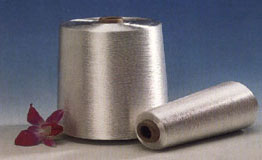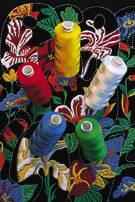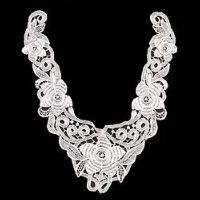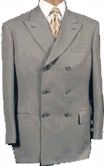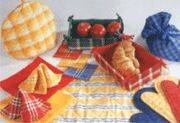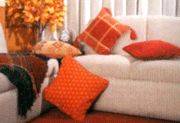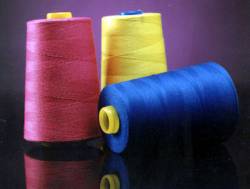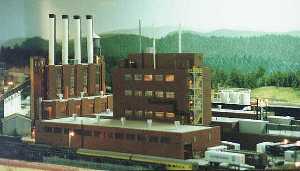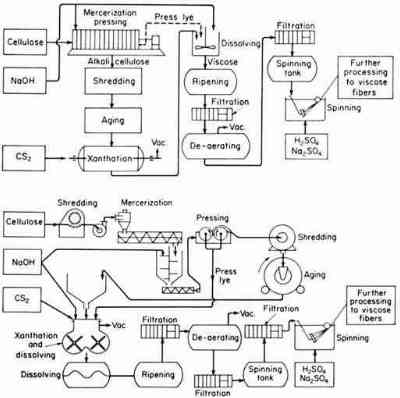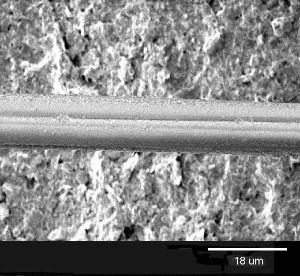
| ||||||||||||||||||||||||||||||||||||||||||||||||||||||||||||||||||||||||||||||||||||
 |
Rayon viscose
Introduction Of all the fibers, rayon is probably the most perplexing to consumers. It can be found in cotton-like end uses, as well as sumptuous velvets and taffetas. It may function successfully in absorbent hygiene and incontinence pads and equally well providing strength in tire cords. What is this fiber that has so many faces? Rayon was the first manufactured fiber. The term rayon was officially adopted by the textile industry. Unlike most man-made fibers, rayon is not synthetic. It is made from wood pulp, a naturally-occurring, cellulose-based raw material. As a result, rayon's properties are more similar to those of natural cellulosic fibers, such as cotton or linen, than those of thermoplastic, petroleum-based synthetic fibers such as nylon or polyester.Although rayon is made from wood pulp, a relatively inexpensive and renewable resource, processing requires high water and energy use, and has contributed to air and water pollution. Modernization of manufacturing plants and processes combined with availability of raw materials has increased rayon's competitiveness in the market.
HistoryRayon is the generic term for fiber (and the resulting yarn and fabric) manufactured of regenerated cellulose by any one of six processes. Its importance as a fiber lies in its versatility, and in the fact that it was the first viable manufactured fiber. As far back as 1664, English naturalist Robert Hooke theorized that artificial filaments might be spun from a substance similar to that which silkworms secrete to make silk. This was often tried by scientists in the ensuing years who sought an "artificial silk", yet no one was to succeed until in 1855 the Frenchman did so, George Audemars. By dipping a needle into a viscous solution of mulberry bark pulp and gummy rubber, he was able to make a thread. While interesting from a scientific standpoint, this process was hardly viable economically - it was very slow, and required a great deal of skill and precision.
The first commercial synthetic fiber was produced by Hilaire de Bernigaud, Count of Chardonnay (1839-1924) after 29 years of research, was patented in 1884, and manufactured by him in 1889. This cellulose-based fabric known as Chardonnay silk was pretty but very flammable, it was removed from the market. Soon after, the English chemist Charles Frederick Cross and his collaborators Edward John Bevan and Clayton Beadle discovered the viscose process in 1891 (1892?). Courtaulds Fibers produced the first commercial viscose rayon in 1905; the first in the United States was in 1910 by the American Viscose Company. Initially rayon was called "Artificial Silk", and many other names. In 1924 (1926?), a committee formed by the U.S. Department of Commerce and various commercial associations decided upon the name "rayon". It was called "rayon" for one of two reasons: either because of its brightness and similarities in structure with cotton (sun = ray, -on = cotton). Or because the naming committee couldn't find a name from the thousands entered in a contest they sponsored, and who hoped to shed a "ray of light" on the subject (from rayon, French for ray).
Viscose Rayon has a
silk-like aesthetic with superb drape and feel and retains its rich
brilliant colors. Its
cellulosic base contributes many properties similar to those of
cotton or other natural cellulosic fibers. Rayon is moisture absorbent (more so
than cotton), breathable, comfortable to wear, and easily dyed in
vivid colors.
It does not build up static electricity, nor will it pill unless the fabric is
made from short, low-twist yarns.
Rayon is comfortable, soft to the skin, and
has moderate dry strength and abrasion resistance. Like other cellulosic fibers,
it is not resilient, which means that it will wrinkle. Rayon withstands ironing
temperatures slightly less than those of cotton. It may be attacked by
silverfish and termites, but generally resists insect damage. It will mildew,
but that generally is not a problem.
One of rayon's strengths is its versatility and ability to blend easily with
many fibers—sometimes to reduce cost, other times for lustre, softness, or
absorbency and resulting comfort.
Rayon has moderate resistance to acids and alkalis and generally the fiber
itself is not damaged by bleaches; however, dyes used in the fabric may
experience color change. As a cellulosic fiber, rayon will burn, but flame
retardant finishes can be applied.
There are four major types or modifications of rayon. Understanding each type
should help clarify differences in product performance.
Other types of rayon have been developed for specialized end uses. These
include disposable, non-woven markets, and high-absorption rayon fibers with
moisture-holding properties for disposable diapers, hygiene and incontinence
pads, as well as medical supplies.
Microfibers are not a type of rayon, but rather a very fine fiber that
can be manufactured from either regular or HWM rayon. Microfibers are generally
less than one denier in diameter. Rayon microfibers have
been successfully produced at 0.9 denier. Fabrics from microfibers are very
drapable and silk-like in hand and appearance.
By using two different chemicals and manufacturing techniques, two basic
types of rayon were developed - viscose rayon and cuprammonium. Other processes
for rayon include the polynosic (modal) process and the now obsolete
nitrocellulose and saponified acetate processes. The nitrocellulose process is
likely obsolete not only because the viscose and cuprammonium processes are more
effective, they are also safer; the nitrocellulose process results in a fiber
with explosive properties.
As recently as 1992 there has been an entirely new process developed for
producing regenerated cellulose fibers: the Lyocell process, developed by
Courtaulds. While it is sufficiently different from rayon to almost be in a
class by itself, the U.S. Federal Trade commission has formally amended the
textile rules to add Lyocell as a subclass of rayon.
As viscose is the most common and recognized process for making rayon today,
the process is outlined below. While the United States government considers
fibers from all the above processes rayon, the International Organization for
Standardization (ISO) prefers the name viscose for rayon (regenerated cellulose)
obtained by the viscose process. The name viscose was derived from the word
viscous, which describes the liquid state of the spinning solution.
Dissolution Extrusion Purification
The structure of the rayon fiber is generally that of smooth, inelastic
filaments like glass rods. However, different processes, additives and finishing
techniques can vary the physical appearance and structure of the fiber.
In the burning test, rayon most resembles cotton. It ignites rapidly,
sometimes even faster than cotton, burning with a large, bright, yellow flame.
Burnt rayon leaves an odor like burnt paper, similar to cotton. The ash is also
like cotton: light and feathery gray, which disintegrates rapidly.
In the feeling test, rayon is more difficult to identify. The variety of
processes, modifications of technique and various treatments can make rayon look
and feel like silk, cotton, wool or linen. In general, however, rayon has the
smooth feeling of silk. The breaking test can differentiate between rayon, cotton and linen yarns.
Because of its inelasticity, rayon will tend to break shortly, with a short,
uneven breaking pattern. It is even easier to distinguish when wet, as it breaks
very easily then.
The critical element in successful care of rayon is the type of fiber.
The
low wet strength of untreated viscose rayon is likely to cause shrinkage and
loss of body if fabrics made from these fibers are hand or machine washed.
Viscose rayon are usually labeled "dry clean only." Check and follow
garment labels for care and instructions. Consumers who do not follow care
instructions will have no recourse to manufacturers should damage occur during
laundering.
Since many dyes and finishes applied to viscose rayon are moisture-sensitive,
consumers should protect garments from contact with moisture. Raincoats should
be worn on stormy days. Also, care should be used when washing hands or working
in the kitchen to avoid splashing water. The problem with sizing or dye
migration increases the longer the area remains damp. Spills or moisture should
be blotted with absorbent cloth to remove moisture. Avoid spilling acid or
alkali, such as foodstuffs or perfume, as certain dyes used on rayon are
especially sensitive to these substances. Use caution or avoid treating stained
areas with water. Take the garment to a dry cleaner for stain removal. Rings or
darker shading caused by sizing migration and lighter areas resulting from dye
migration may be permanent.
When viscose rayon can be hand washed, do so with care. Always support wet
fabrics, since rayon has low wet strength and is unstable when wet. Avoid
wringing moisture from fabrics. Gently squeeze out moisture and roll in a towel.
Smooth and shape, then lay flat to dry. If the garments are not too heavy when
wet, they can be hung on a non-rusting hanger.
When pressing regular rayon garments at home, guard against spitting by steam
irons that may cause water spots. Also, if possible, press on the wrong side or
use a press cloth on the right side to avoid shine or iron imprints. Use a rayon
or synthetic setting on the iron. When pressing blends, use the iron temperature
for the most heat-sensitive fiber. Normally, a synthetic setting will be
satisfactory.
High wet modulus or polynosic rayons can usually be machine washed or dried
without special care. Blends, dark colors, and permanent press fabrics should be
washed on a gentle cycle with warm water; however, 100 percent high wet modulus
rayons are normally not damaged by hot water temperatures (more than 140°F).
Tumble dry on a warm setting and remove immediately, or while slightly damp.
Smooth and hang to reduce wrinkling. Polynosic rayons can be line dried;
however, heavy items should be supported by clotheslines to avoid stretching or
loss of shape.
Rayon is probably the most misunderstood of all fibers. It is not a natural
fiber, yet it is not synthetic. It is a fiber formed by regenerating natural
materials into a usable form.
Rayon fibers and fabrics made from them have many desirable properties.
However, consumers sometimes expect performance characteristics beyond those for
which rayon fibers were designed. Although rayon can look like wool, silk,
cotton, or linen and is a manufactured fiber like polyester, this does not mean
it behaves like or has the same properties or care requirements of these fibers.
Rayon is a fiber on its own. Consider each garment made from rayon individually
when determining use and care practices.
And, always read and follow care labels for best performance.
| |||||||||||||||||||||||||||||||||||||||||||||||||||||||||||||||||||||||||||||||||||
| Be notified of page updates |
wwwswicofilcom2015

